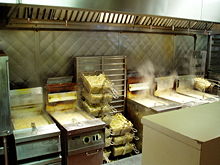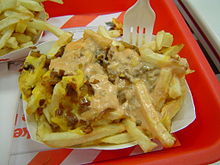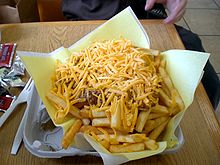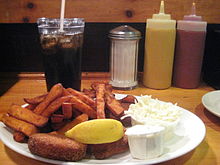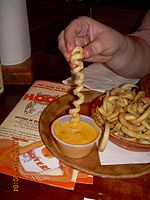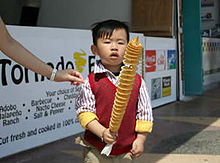- French fries
-
"pommes" redirects here. For similar terms, see Poms.
French fries 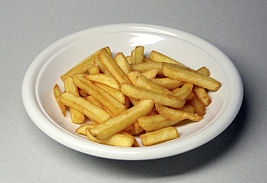
A dish of French friesOrigin Alternative name(s) Belgian fries, chips, hot chips, fries, French-fried potatoes, steak fries, wedges, potato wedges, frites Place of origin Belgium Dish details Course served Side dish or, rarely, as a main dish or as a snack. Serving temperature Hot, generally salted, often served with ketchup, vinegar, barbecue sauce, mayonnaise, or other sauces on the side Main ingredient(s) Potatoes and oil French fries (American English, with "French" often capitalized[1]), chips, fries,[2] or French-fried potatoes are strips of deep-fried potato.[3] North Americans tend to refer to any pieces of deep-fried potatoes as fries or French fries, while in the United Kingdom, Australia, Ireland and New Zealand, long, thinly cut slices of deep-fried potatoes (especially from fast-food outlets) are often called fries to distinguish them from chips (which are traditionally fatter and less elongated).[4] French fries are known as frites, patates frites or pommes frites in French, a name which is also used in many non-French-speaking areas, while others may have names that mean "fried potatoes" or "French potatoes". "Steak-frites" is widely considered the most typical French national meal, as are a "burger and fries" in America, and frites on their own are a Belgian culinary specialty.
Contents
Etymology
Thomas Jefferson had "potatoes served in the French manner" at a White House dinner in 1802.[5][6] The expression "French Fried Potatoes" first occurs in print in English in the 1856 work Cookery for Maids of All Work by E. Warren: "French Fried Potatoes. – Cut new potatoes in thin slices, put them in boiling fat, and a little salt; fry both sides of a light golden brown colour; drain."[7] In the early 20th century, the term "French fried" was being used in the sense of "deep-fried", for other foods such as onion rings or chicken.[8][9]
It is unlikely that 'French fried' refers to 'frenching' in the sense of "julienning", which is not attested until after 'French fried potatoes'; previously, Frenching referred only to trimming the meat off the shanks of chops.[10]
Culinary origin
Belgium
Belgian journalist Jo Gérard has claimed that a family manuscript dated 1781 recounts that potatoes were fried prior to 1680 in what was then the Spanish Netherlands (present-day Belgium), in the Meuse valley: "The inhabitants of Namur, Andenne, had the custom of fishing in the Meuse for small fish and frying, especially among the poor, but when the river was frozen and fishing became hazardous, they cut potatoes in the form of small fish and put them in a fryer like those here".[11][12] Gérard has not produced the manuscript supporting this claim which, even if true, is unrelated to the later history of the French fry, as the potato did not arrive in the region until around 1735; also, given the economic conditions of the 18th century: "it is absolutely unthinkable that a peasant could have consecrated large quantities of fat for cooking potatoes. At most they were sautéed in a pan...."[13] Some Belgians believe that the term "French" was introduced when American soldiers arrived in Belgium during World War I, and consequently tasted Belgian fries. They supposedly called them "French", as it was the official language of the Belgian Army at that time.[11] At this time French fries were growing popular. However, in the south of Netherlands, bordering Belgium, they are called Vlaamse Frieten or "Flemish fries".
"Pommes frites", "frites"(French) or "frieten" (Dutch) became the national snack and a substantial part of several national dishes.
Shortly after the May 1940 invasion of Belgium by the Wehrmacht, Hitler attempted to ban "french fries" because they were the central nutritional source of the Belgian resistance due to their simplicity and availability.[dubious ]
France and French-speaking Canada
In France and French-speaking Canada, fried potatoes are formally "pommes de terre frites",[14] but more commonly "pommes frites", "patates frites", or simply "frites". The word "aiguillettes" or "allumettes" is used when the chips are very small and thin.
Eating potatoes was promoted in France by Parmentier, but he did not mention fried potatoes in particular. Many Americans attribute the dish to France and offer as evidence a notation by U.S. President Thomas Jefferson. "Pommes de terre frites à cru, en petites tranches" ("Potatoes deep-fried while raw, in small cuttings") in a manuscript in Thomas Jefferson's hand (circa 1801-1809) and the recipe almost certainly comes from his French chef, Honoré Julien.[15] In addition, from 1813[16] on, recipes for what can be described as French fries occur in popular American cookbooks. By the late 1850s, one of these mentions the term "French fried potatoes".[17]
Frites are the main ingredient in the Québécois dish known as poutine, comprising fried potatoes covered with cheese curds and brown gravy, a dish with a growing number of variations.
Great Britain
Chips
See also: Fish and chipsThe first chips fried in Britain were on the site of Oldham's Tommyfield Market in 1860.[18] A blue plaque in Oldham marks the origin of the fish and chip shop and fast food industries in Britain.[19] In Scotland, chips were first sold in Dundee, "...in the 1870s, that glory of British gastronomy – the chip – was first sold by Belgian immigrant Edward De Gernier in the city’s Greenmarket."[20]
Traditionally, "chips" in the British Isles (and Australia and New Zealand), are cut much thicker, typically between 9.5 and 13 mm (3/8–1/2 inches) wide. Since the surface-to-volume ratio is lower, they have a lower fat content. Thick-cut, or beefsteak, British chips are occasionally made from unpeeled potatoes to enhance their flavor and nutritional value and are not necessarily served as crisp as the European French fry due to their relatively high water content.
As with all members of the deep-fried chip family, they are cooked twice, once at a relatively low temperature (blanching) to cook the potato, and then at a higher temperature to crisp the surface, making them crunchy on the outside and fluffier on the inside.
Chips are part of the popular take-out dish fish and chips. In the United Kingdom, Australia, Ireland, and New Zealand, few towns are without a fish and chip shop. In these countries, the term "Fries" usually refers to the narrow-cut (shoestring) items that are served by American-style fast-food shops.
Spain
In Spain, fried potatoes are called "patatas fritas". Another common form, in which the potatoes are cut into irregular shapes and seasoned with a spicy tomato sauce, is called "patatas bravas".
Some speculate that the dish may have been invented in Spain, the first European country in which the potato appeared via the New World colonies, and assumes the first appearance to have been as an accompaniment to fish dishes in Galicia,[citation needed] from which it spread to the rest of the country and further to the Spanish Netherlands, which became Belgium more than a century later.
Professor Paul Ilegems, curator of the Friet-museum in Antwerp, Belgium, believes that Saint Teresa of Ávila fried the first chips, referring also to the tradition of frying in Mediterranean cuisine.[12][21]
Spreading popularity
Frozen fries
The J. R. Simplot Company is credited with successfully commercializing French fries in frozen form during the 1940s. Subsequently, in 1967, Ray Kroc of McDonald's contracted the Simplot company to supply them with frozen fries replacing fresh cut potatoes.
In 2004, 29% of the United States' potato crop were used to make frozen fries – 90% consumed by the food services sector and 10% by retail.[22] It is estimated that 80% of households in the UK buy frozen fries each year.[23]
Canada's McCain Foods is the world's leading producer of frozen fries. In addition to household products, they supply frozen fries to fast food companies such as McDonald's and KFC.
Belgium and the Netherlands
Fries are very popular in Belgium and the Netherlands. In Belgium you can buy fries in special places called "friteries" (Wallonia and Brussels) or "frietkot"/ "fritkot" (Brussels and Flanders). They are served with a large variety of sauces and eaten either on their own or in the company of other snacks as fricandelle or burgers. Traditionally, they are served in a "cornet de frites" (French) or "frietzak"/"fritzak" (Dutch), a conic white piece of cardboard then wrapped in a piece of paper, with a good spoonful of sauce on the top. With the fries they serve many traditional fastfood products, such as frikandel, gehaktbal or kroket. In the Netherlands, you can find them in a snack bar. They are served mostly with mayonnaise or curry.
In most of the Netherlands, French Fries are called 'patat', whereas in the southern Netherlands and in Belgium, they are named friet. In the Netherlands 'Flemish Fries' (Vlaamse friet) is sometimes used for thick fries of good quality.
Friteries and other fast-food establishments tend to offer a number of different sauces for the fries and meats. In addition to ketchup and mayonnaise, it is common to offer many others, with popular options including:[24]
- Aioli, garlic mayonnaise.
- Sauce Andalouse – mayonnaise with tomato paste and peppers.
- Sauce Americaine – mayonnaise with tomato chervil onions, capers and celery.
- "Bicky" Dressing (Gele Bicky-sauce), a commercial brand made from mayonnaise, white cabbage, tarragon, cucumber, onion, mustard and dextrose.
- Curry mayonnaise.
- Look-sauce – mayonnaise with garlic.
- Mammoet-sauce – mayonnaise, tomato, onion, glucose, garlic, soy sauce.
- Sauce "Pickles" – a yellow mayonnaise-based sauce with turmeric, mustard and crunchy vegetable chunks, similar to Piccalilli.
- Samurai-sauce – mayonnaise with sambal oelek.
- Pepper-sauce – mayonnaise with green pepper, garlic, glucose.
- Tartar Sauce.
- Zigeuner sauce – A "gypsy" sauce of tomatoes, paprika and chopped bell peppers, borrowed from Germany.
These sauces are generally also available in supermarkets. Occasionally hot sauces are offered by friteries, including hollandaise sauce, sauce provençale, Béarnaise sauce or even a splash carbonade flamande stew from an ever-bubbling pot, in the spirit of British "Chips and Gravy".
United States influence
Although chips were already a popular dish in most Commonwealth countries, the thin style of French fries has been popularized worldwide in part by U.S.-based fast food chains such as McDonald's, Burger King, Wendy's, and Arby's.[citation needed]
Pre-made French fries have been available for home cooking since the 1960s, usually having been pre-fried (or sometimes baked), frozen and placed in a sealed plastic bag.
Later varieties of French fries include those which have been battered and breaded, and many U.S. fast food and casual-food chains have turned to dusting with kashi, dextrin, and other flavor coatings, for crispier fries with particular tastes. Results with batterings and breadings, followed by microwaving, have not achieved widespread critical acceptance. Oven frying delivers a dish different from its traditionally fried counterpart.[25]
Variants
Animal fries (covered with cheese, grilled onions, and spread) from In-N-Out Burger's secret menu
There are variants of French fries, including "thick-cut fries", "steak fries", "shoestring fries", "jojos", "crinkle fries", "curly fries", "hand-cut fries" and "tornado fries". Fries cut thickly with the skin left on are called potato wedges, and fries without the potato skin are called "steak fries", essentially the American equivalent of the British "chip". They can also be coated with breading, spices, or other ingredients, which include garlic powder, onion powder, black pepper, paprika, and salt to create "seasoned fries", cheese to create "cheese fries", or chili to create "chili fries". Sometimes, French fries are cooked in the oven as a final step in the preparation (having been coated with oil during preparation at the factory): these are often sold frozen and are called "oven fries" or "oven chips". Some restaurants and groceries in North America offer French fries made from sweet potatoes instead of traditional white potatoes.[citation needed] Crinkle fries maintain their flavor due to their shape, which creates small air pockets that trap the flavoring.
In France, the thick-cut fries are called "Pommes Pont-Neuf"[26] or simply "pommes frites", about 10 mm; thinner variants are "pommes allumettes" (matchstick potatoes), ±7 mm, and "pommes pailles" (potato straws), 3–4 mm (roughly ⅜, ¼ and ⅛ inch respectively). The two-bath technique is standard (Bocuse). "Pommes gaufrettes" or "waffle fries" are not typical French fried potatoes, but actually crisps obtained by quarter turning the potato before each next slide over a grater and deep-frying just once.[27]
Jean Ceustermans, a Belgian chef patented "Steppegras" ("prairie grass"), his variety of extremely thin-cut French fried potatoes developed in 1968 while working in Germany. The name refers to a dish including its particular sauce, and to his restaurant.[28]
In an interview, Burger King president Donald Smith said that his chain's fries are sprayed with a sugar solution shortly before being packaged and shipped to individual outlets. The sugar caramelizes in the cooking fat, producing the golden color customers expect. Without it, the fries would be nearly the same color outside as inside: pasty yellow. Smith believes that McDonald's also sugar-coats its fries. McDonald's was assumed to fry their fries for a total time of about 15 to 20 minutes, and with fries fried at least twice. The fries appear to contain beef tallow, or shortening.[29]
Spiral fries
Curly fries
Curly fries are characterized by their spring-like shape. They are generally made from whole potatoes that are cut using a specialized spiral slicer. They are also typically characterized by the presence of additional seasonings (which give the fries a more orange appearance when compared to the more yellow appearance of standard fries), although this is not always the case.
Sometimes they are packaged for preparation at home, often in frozen packs. In the US they can also be found at a number of restaurants and fast food outlets like Arby's and Hardee's, where they are served with condiments such as ketchup, cheese, fry sauce, or sweet chili sauce and sour cream.
Tornado Fries
Tornado Fries are made by skewering the whole potato, and then cutting with a specialized spiral slicer. The potato is spread evenly along the skewer and deep fried. The cooking process fuses the potato to the skewer and holds it in place. It is then sprinkled with dry seasonings or served with dipping sauce. The Tornado Fry gets its name from the tornado-like shape that the potato has on the skewer. Tornado fries were created in South Korea around 2001 and introduced to North America in 2005.
Accompaniments
Main article: List of accompaniments to french friesFries can be served with a variety of accompaniments, e.g. salt and vinegar (malt, balsamic or white), pepper, grated cheese, melted cheese, mushy peas, heated curry sauce, curry ketchup (mildly spiced mix of the former), hot or chili sauce, mustard, mayonnaise, bearnaise sauce, tartar sauce, tzatziki, feta cheese, garlic sauce, fry sauce, ranch dressing, barbecue sauce, gravy, aioli, brown sauce, tomato ketchup, lemon-juice, piccalilli, pickled cucumber, pickled gherkins, pickled onions or pickled eggs.
Health aspects
French fries can contain a large amount of fat from frying. A 13 year long observation performed by the University of Maastricht, the Netherlands, on 120,000 subjects between 55 and 70, has shown that increased intake of acrylamide (formed when potatoes are baked or fried) is correlated with a 60% higher rate of kidney cancer.[30] (see acrylamides). However, researchers from the Harvard School of Public Health and the Karolinska Institute in Stockholm, Sweden, found no association between the consumption of foods high in acrylamide and increased risk of three forms of cancer: bladder, large bowel and kidney.[31]
Frying French fries in beef tallow, lard, or other animal fats adds saturated fat to the diet. Replacing animal fats with tropical vegetable-oils, such as palm oil, simply substitutes one saturated fat for another. Replacing animal fats with partially hydrogenated oil reduces cholesterol but adds trans fat, which has been shown to both raise LDL cholesterol and lower HDL cholesterol. Canola/Rapeseed oil, or sunflower-seed oil are also used, as are mixes of vegetable oils, but beef tallow is generally more popular, especially amongst fast food outlets that use communal oil baths.[32][33][34] Many restaurants now advertise their use of unsaturated oils. Five Guys, for example, advertises their fries are prepared in peanut oil, while Chick-fil-A advertises that they use canola oil.
Legal issues
In 1994 Peter Stringfellow, the owner of Stringfellows nightclub in London, took exception to McCain Foods' use of the name "Stringfellows" for a brand of long thin chips and took them to court. He lost the case (Stringfellows v McCain Food (GB) Ltd (1994)) on the basis that there was no connection in the public mind between the two uses of the name, and therefore McCain's product would not have caused the nightclub to lose any sales.[35][36]
In June 2004, the United States Department of Agriculture, with the advisement of a federal district judge from Beaumont, Texas, classified batter-coated French fries as a vegetable under the Perishable Agricultural Commodities Act. This was primarily done for trade reasons – French fries do not meet the standard to be listed as a "processed food".
In 2002, the McDonald's Corporation agreed to donate $10 million to Hindu and other groups to settle lawsuits filed against the chain for mislabeling French fries and hash browns as vegetarian,[37] because their French fries and hash browns were found to contain beef extract added during production.
See also
References
- Notes
- ^ "french fries – Definition". Merriam-Webster Online Dictionary. 2007-04-25. http://www.merriam-webster.com/dictionary/french+fries. Retrieved 2009-05-07.
- ^ "The American Heritage Dictionary, Fourth Edition, 2000". Bartleby.com. http://www.bartleby.com/61/68/F0346800.html. Retrieved 2009-05-07.
- ^ "french fry – Definition". Food & Culture Encyclopedia. http://www.answers.com/topic/french-fry. Retrieved 2009-12-05.
- ^ Halliburton, Rachel; Muir, Jenni (2008). "London's best chips". Time Out London: p. 2. http://www.timeout.com/london/restaurants/features/3254/2.html. Retrieved 2008-05-14.
- ^ name=Ebeling, Charles (2005-10-31). "French fried: From Monticello to the Moon, A Social, Political and Cultural Appreciation of the French Fry". The Chicago Literary Club.http://www.chilit.org/Papers%20by%20author/Ebeling%20--%20French%20Fried.htm/
- ^ Fishwick, Marshall W (1998). fee required "The Savant as Gourmet". The Journal of Popular Culture (Oxford: Blackwell Publishing) 32 (part 1): 51–58. doi:10.1111/j.0022-3840.1998.3201_51.x. http://www.blackwell-synergy.com/doi/abs/10.1111/j.0022-3840.1998.3201_51.x fee required.
- ^ http://oed.com/view/Entry/74478?redirectedFrom=french%20fried%20potatoes#eid126068802
- ^ Mackenzie, Catherine (7 April 1935). "Food the City Likes Best". The New York Times Magazine: SM18. http://select.nytimes.com/gst/abstract.html?res=F4081FF83B59107A93C5A9178FD85F418385F9. Retrieved 2007-04-15. "… the chef at the Rainbow Room launches into a description of his special steak, its French-fried onion rings, its button mushrooms …"
- ^ Rorer, Sarah Tyson (c1902). "Page 211". Mrs. Rorer's New Cook Book. Philadelphia: Arnold & Company. p. 211. http://digital.lib.msu.edu/projects/cookbooks/coldfusion/display.cfm?ID=rore&PageNum=259. Retrieved 2007-04-12. "French Fried Chicken"
- ^ Oxford English Dictionary, June 2010
- ^ a b Frites.be
- ^ a b Ilegems, Paul (1993) [1993] (in Dutch). De Frietkotcultuur. Loempia. ISBN 90-6771-325-2.
- ^ Pierre Leclercq, « La véritable histoire de la pomme de terre frite [archive] », www.gastronomica.be, 2 février 2010, mentioning the work of Fernand Pirotte on the history of the potato
- ^ starting in the late 18th century
- ^ Ebeling, Charles (2005-10-31). "French fried: From Monticello to the Moon, A Social, Political and Cultural Appreciation of the French Fry". The Chicago Literary Club. http://www.chilit.org/Papers%20by%20author/Ebeling%20--%20French%20Fried.htm. Retrieved 12 January 2007.
- ^ Ude, Louis. The French Cook
- ^ Warren, Eliza (uncertain: 1856, 1859?). The economical cookery book for housewives, cooks, and maids-of-all-work, with hints to the mistress and servant. London: Piper, Stephenson, and Spence. p. 88. OCLC 27869877. http://books.google.com/?id=AkMCAAAAQAAJ&dq=eliza+warren+cookery+%7C+cookbook+%7C+cooking&q=%22french+fried+potatoes%22. "French fried potatoes"
- ^ Chaloner, W. H.; Henderson, W. O. (1990). Industry and Innovation: Selected Essays. Taylor & Francis.
- ^ The Portuguese gave us fried fish, the Belgians invented chips but 150 years ago an East End boy united them to create The World's Greatest Double Act Mail Online. Retrieved 21 September 2011
- ^ "Dundee Fact File". Dundee City Council. http://www.dundeecity.gov.uk/departments/fact.htm. Retrieved 20 March 2007.
- ^ Schoetens, Marc (December 13, 2005). "Heilige Teresa bakte de eerste frieten" (in Dutch). De Morgen. http://www.demorgen.be/gastronomie/artikels/?id_article=ODA4&ih=h=h=. Retrieved October 25, 2006.[dead link] (Feb 25 2007 found archived as "Nieuw boek van frietprofessor Paul Ilegems over frietkotcultuur" 20051213.3133206672696574)
- ^ FAS.usda.gov
- ^ Lovechips.co.uk
- ^ (French) "La Frite se mange-t-elle à toutes les sauces?". Frites.be. 2011. http://www.frites.be/v4/index.cfm?context=article&ContentID=712. Retrieved April 20, 2011.
- ^ Gerdes, Sharon (1 December 2001). "Batters and Breadings Liven Tastes". Virgo Publishing © – Food Product Design. Archived from the original on 27 September 2007. http://web.archive.org/web/20070927220513/http://www.foodproductdesign.com/articles/465/465_1201de.html. Retrieved 24 March 2007.
- ^ Evelyn Saint-Ange, Paul Aratow (translator), La Bonne Cuisine de Madame E. Saint-Ange: The Essential Companion for Authentic French Cooking, Larousse, 1927, translation Ten Speed Press, 2005, ISBN 1-58008-605-5, p. 553.
- ^ "Les pommes gauffrettes" (in French). "Chef Simon" Sabine et Bertrand SIMON cole. http://chefsimon.com/gaufrette.htm. Retrieved April 9, 2007.
- ^ "Steppegras" (in Flemish). Restaurant Steppegras. http://www.steppegras.org. Retrieved April 17, 2007.
- ^ Poundstone, William (1983) [1983]. Big Secrets. William Morrow and Co.. p. 23. ISBN 0-688-04830-7.
- ^ "Frieten zijn nu officieel kankerverwekkend". University of Maastricht Holland. http://www.gva.be/nieuws/wetenschap/frieten-zijn-nu-officieel-kankerverwekkend.aspx?cmt=all. Retrieved 8 November 2010.
- ^ "Study Shows Acrylamide In Baked And Fried Foods Does Not Increase Risk Of Certain Cancers In Humans". Harvard School of Public Health. http://www.hsph.harvard.edu/news/press-releases/archives/2003-releases/press01282003.html. Retrieved 3 December 2010.
- ^ "Fats and Cholesterol". Harvard School of Public Health. http://www.hsph.harvard.edu/nutritionsource/fats.html. Retrieved 14 September 2006.
- ^ "Trans: The Phantom Fat". Nutrition Action Healthletter (Center for Science in the Public Interest). http://www.cspinet.org/nah/septrans.html. Retrieved 14 September 2006.
- ^ Mayo Clinic Staff (22 June 2006). "Dietary fats: Know which types to choose © 1998-2006". Mayo Foundation for Medical Education and Research (MFMER). http://www.mayoclinic.com/health/fat/NU00262. Retrieved 14 September 2006.
- ^ Solomon, Nicola. "Sequel opportunities". AKME Publications – Akme Student Law Library, with permission: earlier published in the New Law Journal, 25 March 1994 and in abridged form in The Author of Spring 1994. http://www.akme.btinternet.co.uk/solomn05.html. Retrieved 2007-03-25.
- ^ "Section 7 – Intellectual Property" (PDF). Semple Piggot Rochez Ltd. 2001. Archived from the original on 2006-10-12. http://web.archive.org/web/20061012014129/http://www.legalpractitioner.co.uk/ip1.pdf. Retrieved 2007-03-25.
- ^ Grace, Francie (June 5, 2002). "McDonald's Settles Beef Over Fries". CBS News. http://www.cbsnews.com/stories/2002/06/05/national/main511109.shtml. Retrieved 4 May 2011.
- Bibliography
- Bocuse, Paul (December 10, 1998) (in French). La Cuisine du marché. Paris: Flammarion. ISBN 978-2082025188.
- Tebben, Maryann (2006). "French Fries: France’s Culinary Identity from Brillat-Savarin to Barthes (essay)". Convivium Artium. University of Texas at San Antonio. http://flan.utsa.edu/conviviumartium/Tebben.html. Retrieved December 28, 2009.
External links
- The Official French Fries Pages – information and fan site (1996-pres.)
- News on French Fries and Potato Processing
- The ultimate chip and perfect mash – Heston Blumenthal recipes
Deep-fried foods Banana chips · Chifle · Chicken fried bacon · Coca Cola · Egg roll · Fish · Finger steaks · French fries · Fried chicken · Fried pickle · Mars bar · Mozzarella sticks · Onion ring · Peanuts · Pizza · Potato chips · Tater tot · Tempura · Tortilla chip · Twinkie
Categories:- Belgian cuisine
- Fast food
- Street food
- Potato dishes
- World cuisine
- Deep fried foods
Wikimedia Foundation. 2010.



